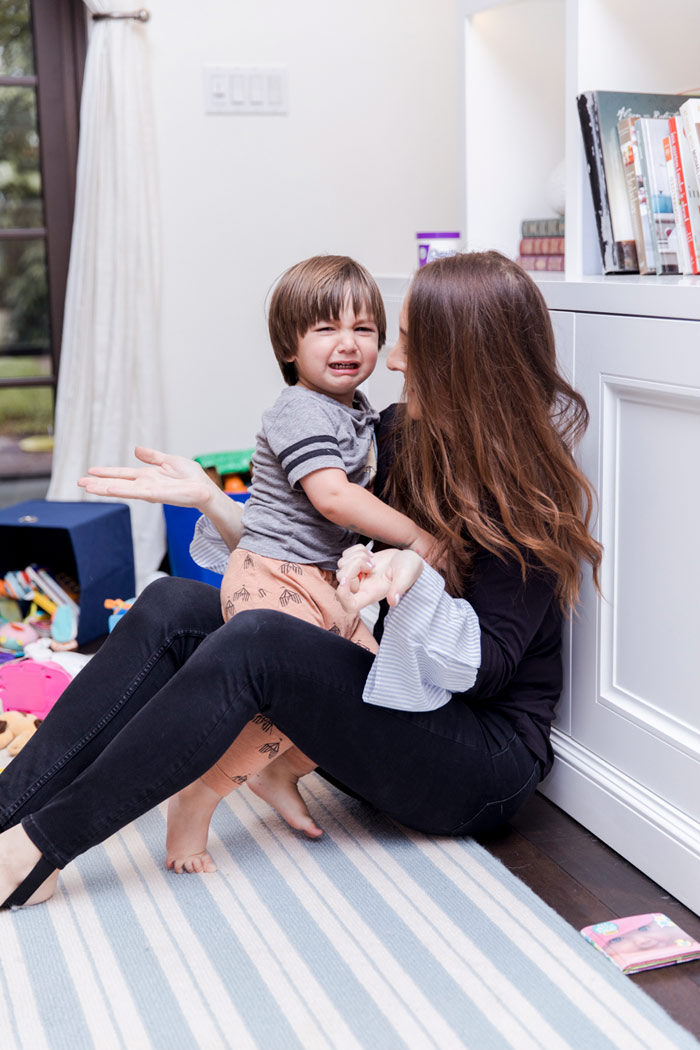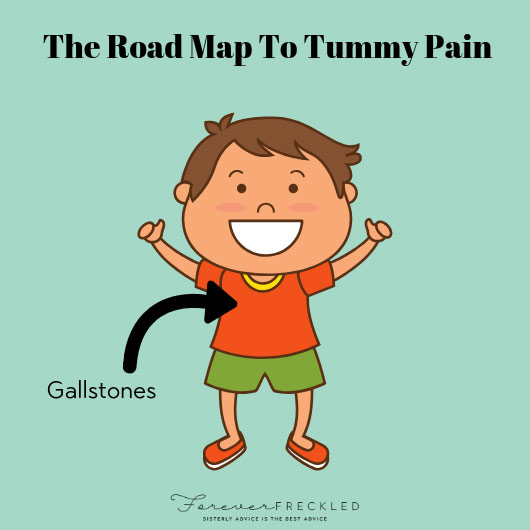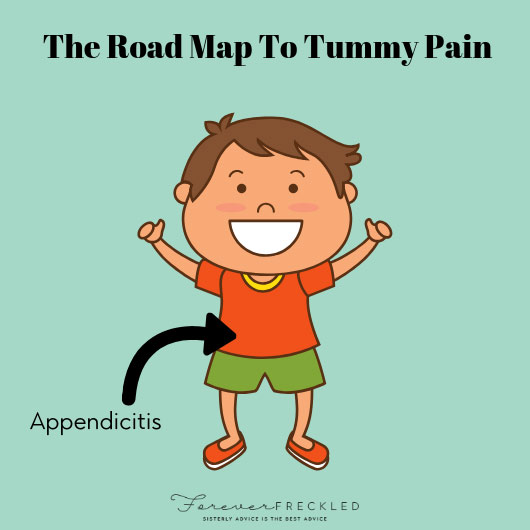
The Ultimate Road Map to Your Child’s Tummy Pain
The dreaded tummy ache! Abdominal pain in children is one of the more common aliments I treat as a pediatrician. There are many things that can cause belly pain. And while some conditions are benign, some can be much more serious. Not knowing the cause of pain leads to anxiety for many parents, especially when there’s a possibility for surgery.
Many factors help doctors determine the cause of abdominal pain – your child’s age, how long your child has had belly pain, the presence or absence of a fever, and other symptoms. But one tool is usually the most useful in helping doctors come to a diagnosis. Just like when buying a house or opening a business, determining the cause of abdominal pain in children is all about LOCATION, LOCATION, LOCATION!
So let’s break down the different areas of the stomach and the most common reasons your child may experience pain in a particular area. While many conditions can cause abdominal pain, today we are only going to touch on the most common causes of belly pain in children. Many ailments require labs and imaging to figure out the ultimate source of a child’s pain.
*Please keep in mind that this is a very general guide. Many things can cause acute abdominal pain in children, and it is very important to have your child evaluated by their pediatrician if they experience severe belly pain.*
The Four Quadrants
In medicine, we divide the abdomen into four major regions, know as the abdominal quadrants. These areas are named by location – the right upper quadrant, the left upper quadrant, the right lower quadrant, and the left lower quadrant. Knowing the relative location of abdominal pain in children helps us gain a better idea of what is causing the discomfort.
Left Upper Quadrant/Upper Midline Pain
The stomach and spleen live in the upper left portion of our abdomen. So when our child complains of pain in the area it is more likely to be related to the stomach. One of the most common causes of upper midline/left quadrant pain is gastritis. Gastritis usually presents with a burning pain in the upper/middle portion of the belly right underneath the sternum. Children might have a difficult time expressing this type of pain and will more likely have general complaints of belly pain, nausea, and decreased appetite.
Diet is very important when trying to alleviate the symptoms of gastritis. There are certain foods that can exacerbate your child’s symptoms. Make sure to avoid spicy foods, tomatoes, citrus, chocolate, and caffeine (found in soda and tea). Gastritis can be caused by a number of things, so it is important to have your child evaluated by the pediatrician. If your child is having severe abdominal pain, vomiting, or black, tarry stools, have them evaluated immediately.
You need to have the right medicines in the house to try and help combat the symptoms. In the past, there wasn’t much on the market to help treat symptoms associated with upset stomach and indigestion. Mylicon has recently come out with a line of Children’s Tummy Relief that is the only multi-symptom product available for upset tummies for kids ages 2-11! They are fast acting, chewable tablets that have active ingredients, including antacids, to treat gas, bloating, and indigestion. 
Right Upper Quadrant Pain
The liver and gallbladder are in the upper right portion of our abdomen. A common reason a child might have pain in this area is hepatitis or gallstones. While less common, gallstones may present with colic pain after eating. It’s not very common to have a child with pain in this quadrant of the abdomen, so any pain here really should be evaluated by your healthcare provider.
Right Lower Quadrant Pain
If your child complains of persistent pain, especially if the pain is located on the right lower side, it may be a sign of appendicitis. Appendicitis typically starts with pain around the belly button, and as it progresses, begins to cause pain in the right lower side. Along with pain on the right side, your child may experience nausea and some vomiting. If your child has pain in this area, take them to their pediatrician to be evaluated immediately. It is extremely important to rule out appendicitis.
Left Lower Quadrant Pain
One of the most common reasons for lower belly pain, particularly in the left lower side is constipation. Constipation is defined as infrequent bowel movements with difficulty or pain passing stool. Constipation can cause a variety of symptoms, making it difficult to diagnosis. Your child will typically complain of a lower belly pain that is crampy in nature. The pain is usually intermittent and worsens after eating. They may also complain of pain with bowel movements and have stool that is hard and dark in consistency. Constipation can also lead to gas pain, which is very sharp and painful. The intense nature of gas pain brings thousands of worried parents to the emergency room annually. It is important to alleviate gas pain as it can cause extreme discomfort for your child.
Children’s Mylicon – Tummy Relief for Kids contains the same active ingredients doctors and parents have trusted for decades for infants, now available in chewable form for older kids. These chewable tablets are fast acting, gentle on the stomach, and safe for ages 2-11.
Once gas pain is under control, you must treat the constipation. Never start your child on a laxative without the guidance of a pediatrician. Your doctor may perform labs and imaging to create a treatment plan that is best for your child. Diet is an important part of healthy digestion. Begin with a high fiber diet, and ensure your child drinks lots of water to alleviate constipation. If at anytime your child is experiencing persistent or worsening abdominal pain, vomiting, or fever, have them evaluated immediately.
Generalized Abdominal Pain in Children
While the location of abdominal pain in children is often the key to determining the cause, some ailments have a more generalized presentation. Pay close attention to your child’s complaints, as this information will help your pediatrician figure out the nature of your child’s pain.
Gastroenteritis
Gastroenteritis is one of the most common reasons for abdominal pain in children. The pain is usually intermittent in nature and associated with an episode of vomiting and diarrhea, unlike with other conditions where the pain is persistent in nature.
Irritable Bowel Syndrome (IBS)
More and more children are being diagnosed with IBS. Irritable bowel syndrome is a gastrointestinal disorder that causes a cluster of symptoms, including abdominal pain, bloating, and bouts of diarrhea and constipation. It presents more commonly in the adolescent population but can occur in any age group. Anxiety or depression have been observed in many children suffering with IBS, although a direct relationship hasn’t been established. Stress, such as occurs when going back to school, can lead to an exacerbation of symptoms. If your child suffers from these symptoms, see your pediatrician. Lab work and imaging may be required for a proper diagnosis.
Functional Abdominal Pain
Functional abdominal pain is the most common cause of chronic abdominal pain in the adolescent population. This pain is recurrent in nature and typically occurs around the belly button. It can be associated with bloating, nausea, and lost of appetite. Functional abdominal pain is a diagnosis of exclusion. Labs and imaging reveal no organic cause for the pain, however, understand this doesn’t mean your child is pain-free or faking the pain. It can be a very frustrating for the child suffering with chronic belly pain and parents alike. Many times, conventional pain management doesn’t work. Diet and alternative methods of pain management may be helpful in the treatment of this type of abdominal pain in children.
Final Thoughts
While we have covered some of the most common causes of tummy aches based on the location of abdominal pain in children, unfortunately we can’t possibly include them all. I have never told a parent it was a mistake to bring their child in for evaluation. The reality is, once you become a parent, you develop what I like to call, “mommy or daddy instinct.” If your instinct says something is not right, immediately have your child evaluated. If a doctor says your child is fine but you still feel something is very wrong, get a second opinion. As parents, we are our children’s only voice!
Dr. Katie



